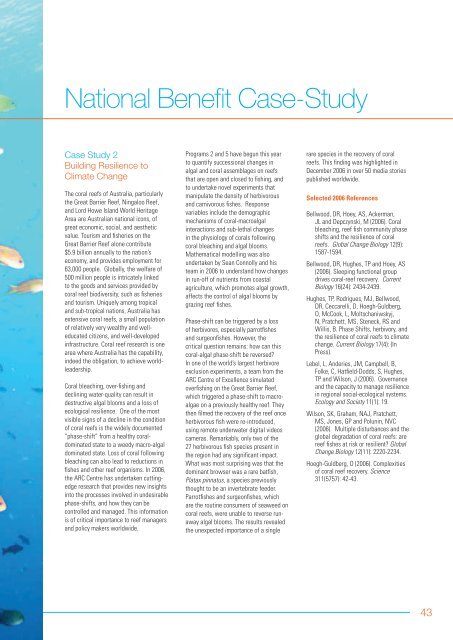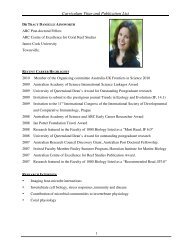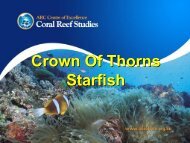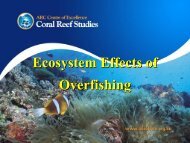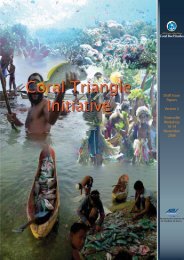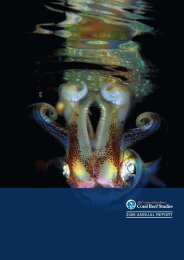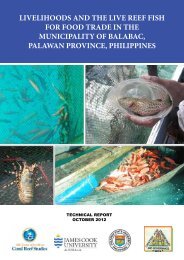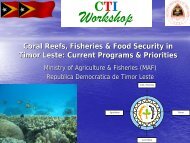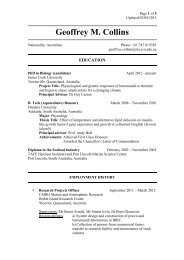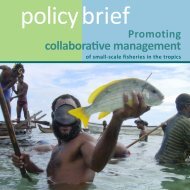Download - ARC Centre of Excellence for Coral Reef Studies
Download - ARC Centre of Excellence for Coral Reef Studies
Download - ARC Centre of Excellence for Coral Reef Studies
Create successful ePaper yourself
Turn your PDF publications into a flip-book with our unique Google optimized e-Paper software.
National Benefi t Case-StudyCase Study 2Building Resilience toClimate ChangeThe coral reefs <strong>of</strong> Australia, particularlythe Great Barrier <strong>Reef</strong>, Ningaloo <strong>Reef</strong>,and Lord Howe Island World HeritageArea are Australian national icons, <strong>of</strong>great economic, social, and aestheticvalue. Tourism and fisheries on theGreat Barrier <strong>Reef</strong> alone contribute$5.9 billion annually to the nation’seconomy, and provides employment <strong>for</strong>63,000 people. Globally, the welfare <strong>of</strong>500 million people is intricately linkedto the goods and services provided bycoral reef biodiversity, such as fisheriesand tourism. Uniquely among tropicaland sub-tropical nations, Australia hasextensive coral reefs, a small population<strong>of</strong> relatively very wealthy and welleducatedcitizens, and well-developedinfrastructure. <strong>Coral</strong> reef research is onearea where Australia has the capability,indeed the obligation, to achieve worldleadership.<strong>Coral</strong> bleaching, over-fi shing anddeclining water-quality can result indestructive algal blooms and a loss <strong>of</strong>ecological resilience. One <strong>of</strong> the mostvisible signs <strong>of</strong> a decline in the condition<strong>of</strong> coral reefs is the widely documented“phase-shift” from a healthy coraldominatedstate to a weedy macro-algaldominated state. Loss <strong>of</strong> coral followingbleaching can also lead to reductions infi shes and other reef organisms. In 2006,the <strong>ARC</strong> <strong>Centre</strong> has undertaken cuttingedgeresearch that provides new insightsinto the processes involved in undesirablephase-shifts, and how they can becontrolled and managed. This in<strong>for</strong>mationis <strong>of</strong> critical importance to reef managersand policy makers worldwide.Programs 2 and 5 have begun this yearto quantify successional changes inalgal and coral assemblages on reefsthat are open and closed to fi shing, andto undertake novel experiments thatmanipulate the density <strong>of</strong> herbivorousand carnivorous fi shes. Responsevariables include the demographicmechanisms <strong>of</strong> coral-macroalgalinteractions and sub-lethal changesin the physiology <strong>of</strong> corals followingcoral bleaching and algal blooms.Mathematical modelling was alsoundertaken by Sean Connolly and histeam in 2006 to understand how changesin run-<strong>of</strong>f <strong>of</strong> nutrients from coastalagriculture, which promotes algal growth,affects the control <strong>of</strong> algal blooms bygrazing reef fi shes.Phase-shift can be triggered by a loss<strong>of</strong> herbivores, especially parrotfishesand surgeonfi shes. However, thecritical question remains: how can thiscoral-algal phase-shift be reversed?In one <strong>of</strong> the world’s largest herbivoreexclusion experiments, a team from the<strong>ARC</strong> <strong>Centre</strong> <strong>of</strong> <strong>Excellence</strong> simulatedoverfi shing on the Great Barrier <strong>Reef</strong>,which triggered a phase-shift to macroalgaeon a previously healthy reef. Theythen fi lmed the recovery <strong>of</strong> the reef onceherbivorous fi sh were re-introduced,using remote underwater digital videoscameras. Remarkably, only two <strong>of</strong> the27 herbivorous fi sh species present inthe region had any signifi cant impact.What was most surprising was that thedominant browser was a rare batfi sh,Platax pinnatus, a species previouslythought to be an invertebrate feeder.Parrotfi shes and surgeonfi shes, whichare the routine consumers <strong>of</strong> seaweed oncoral reefs, were unable to reverse runawayalgal blooms. The results revealedthe unexpected importance <strong>of</strong> a singlerare species in the recovery <strong>of</strong> coralreefs. This fi nding was highlighted inDecember 2006 in over 50 media storiespublished worldwide.Selected 2006 ReferencesBellwood, DR, Hoey, AS, Ackerman,JL and Depczynski, M (2006). <strong>Coral</strong>bleaching, reef fi sh community phaseshifts and the resilience <strong>of</strong> coralreefs. Global Change Biology 12(9):1587-1594.Bellwood, DR, Hughes, TP and Hoey, AS(2006). Sleeping functional groupdrives coral-reef recovery. CurrentBiology 16(24): 2434-2439.Hughes, TP, Rodrigues, MJ, Bellwood,DR, Ceccarelli, D, Hoegh-Guldberg,O, McCook, L, Moltschaniwskyj,N, Pratchett, MS, Steneck, RS andWillis, B. Phase Shifts, herbivory, andthe resilience <strong>of</strong> coral reefs to climatechange. Current Biology 17(4): (InPress).Lebel, L, Anderies, JM, Campbell, B,Folke, C, Hatfi eld-Dodds, S, Hughes,TP and Wilson, J (2006). Governanceand the capacity to manage resiliencein regional social-ecological systems.Ecology and Society 11(1): 19.Wilson, SK, Graham, NAJ, Pratchett,MS, Jones, GP and Polunin, NVC(2006). Multiple disturbances and theglobal degradation <strong>of</strong> coral reefs: arereef fi shes at risk or resilient? GlobalChange Biology 12(11): 2220-2234.Hoegh-Guldberg, O (2006). Complexities<strong>of</strong> coral reef recovery. Science311(5757): 42-43.43


